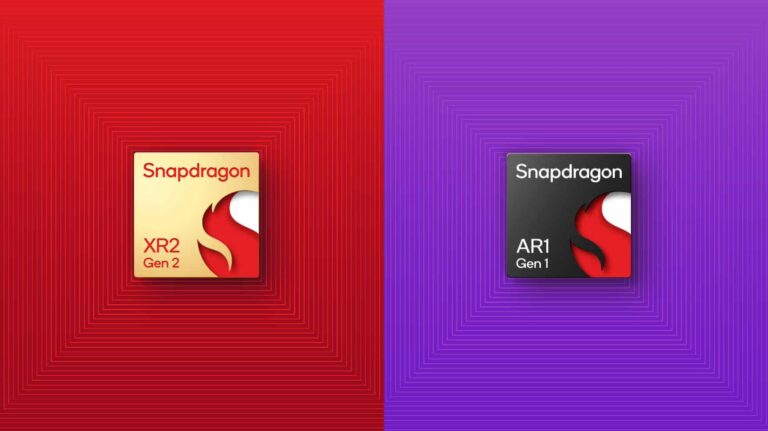
Qualcomm today announced its next wave of chips, purpose-built for AR and VR devices. Unveiled from the stage at Meta Connect (and revealed to us in an embargoed pre-briefing), this one-two punch includes the Snapdragon XR2 Gen 2 and Snapdragon AR1 Gen 1.
In short, the former is meant to power VR and MR devices, while the latter is built for lighter-weight smart glasses. As for the timing, both platforms have been developed in close collaboration with Meta and will commercially debut first on Meta devices (more on that in a bit).
After the Meta-centric debut, both chips will be available and embedded in AR and VR devices from other manufacturers. Qualcomm currently powers 80+ AR and VR devices so it stands to reason that this newest generation of XR-centric chips will quickly elevate to industry standard.
Mixed Future
Going deeper on the new platforms, they uplevel Qualcomm’s previous-generation specs across the board. We’re talking processing speed, GPU performance, and other functions in Qualcomm’s XR-focused chips. As a sign of the times, there’s also a heavy dose of AI.
Taking the new chips one at a time, the XR2 Gen 2 boasts 2.5x higher GPU performance and 8x better AI than XR2 Gen 1. It carries a single-chip architecture built for VR and mixed-reality devices that feature high-quality color passthrough video (e.g., Quest Pro, Vive XR Elite).
The XR2 Gen 2 is also built for speed in terms of intended use cases that span gaming, productivity, entertainment, and the widening range of activities seen in mixed-reality devices. And it’s optimized for increasingly thinner and more comfortable headsets, sans external battery packs.
Putting some numbers behind that, XR2 Gen 2 enables resolutions up to 3K per eye, as well as higher-fidelity positional tracking with 8x better on-device AI compared with XR2 Gen 1. Speaking of AI, it supports accelerated computer vision and up to 10 simultaneous inside-out cameras.
Many of these specs point to VR’s evolution towards mixed reality. When adding up the expanded capabilities, it’s evident that XR2 Gen 2 intends to fuel the next batch of VR devices that blend virtual content with full-color physical surroundings via passthrough cameras.
Smart Look
Moving on to XR2 Gen 2’s AR-focused counterpart, the AR1 Gen 1 is the first dedicated processor for smart glasses. Here, the main distinction behind “smart glasses” is highly wearable devices that resemble eyewear as opposed to the “open helmet” format of devices like Hololens 2.
Similar to the AR2 we covered back in November, the AR1 line is purpose-built for AR glasses – in this case lighter and sleeker formats. Gen 1 is the first commercial appearance of that vision, including concrete specs and performance details that we get to see for the first time.
That list includes a premium dual image signal processor (ISP) for pro-grade photos and videos. This is meant to support the use case for first-person multimedia capture. One example, though it’s not necessarily affiliated with AR1, is Apple Vision Pro’s recently demonstrated Spatial Video.
The platform also supports up to eight microphones for spatial audio capture that does justice to dimensionally-rich video. As for optics, AR1 Gen 1 supports binocular displays that offer more dimensional line-of-sight content including video, wayfinding, and notifications.
And like XR2 Gen 2, there’s a fair amount of AI at play. Specifically, AR1 Gen 1 supports on-device AI for dynamic image and audio enhancements and real-time language translation. AI also plays a key role in visual search, including a “captions for the physical world” use case.
New Firepower
So there you have it… the latest high water mark in spatial computing platforms has been established by Qualcomm. In that sense, this latest wave of chips future proofs Qualcomm’s efforts with a range of current and near-future standards in VR, AR, and mixed reality.
And it’s already getting started. As noted, Meta will utilize these devices first… and as of today, we know what that will look like. Announced today from the Meta Connect Stage, Quest 3 and Ray Ban Stories 2 will utilize the XR2 Gen 2 and AR1 Gen 1, respectively.
Quest 3 will utilize many XR2 Gen 2 specs noted above for higher-resolution full-color passthrough experiences. Mixed Reality use cases will continue to develop around these capabilities, including consumer and enterprise applications that require situational awareness.
Ray-Ban Stories 2 likewise makes use of AR1 Gen 1’s new firepower, including richer audio and video capture for the device’s livestreaming feature. AR1 Gen 1’s AI capabilities will also fuel the central use case as a visual-search-enabled intelligent assistant for real-world discovery.
Where each platform goes from there is unclear in terms of devices that will adopt and embed them. But it’s a fairly safe bet – going by Qualcomm’s positioning as a standard in XR chips – that both chips will get ample mileage throughout the spatial computing competitive landscape.






